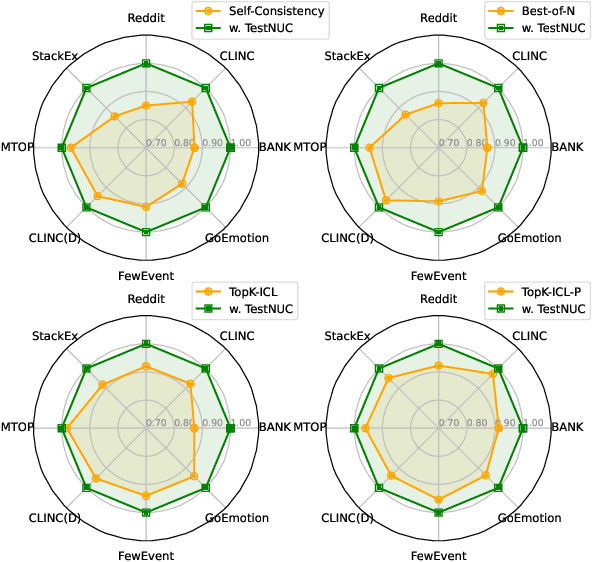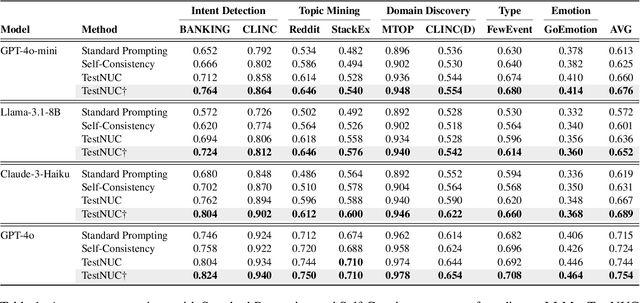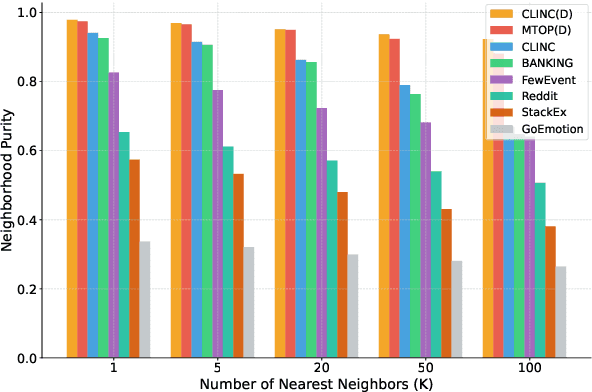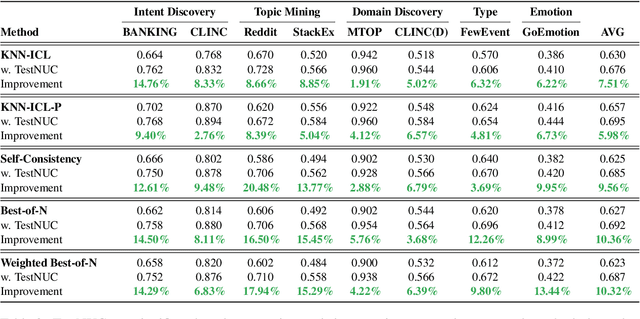Yibo Wang
QUITE: A Query Rewrite System Beyond Rules with LLM Agents
Jun 09, 2025Abstract:Query rewrite transforms SQL queries into semantically equivalent forms that run more efficiently. Existing approaches mainly rely on predefined rewrite rules, but they handle a limited subset of queries and can cause performance regressions. This limitation stems from three challenges of rule-based query rewrite: (1) it is hard to discover and verify new rules, (2) fixed rewrite rules do not generalize to new query patterns, and (3) some rewrite techniques cannot be expressed as fixed rules. Motivated by the fact that human experts exhibit significantly better rewrite ability but suffer from scalability, and Large Language Models (LLMs) have demonstrated nearly human-level semantic and reasoning abilities, we propose a new approach of using LLMs to rewrite SQL queries beyond rules. Due to the hallucination problems in LLMs, directly applying LLMs often leads to nonequivalent and suboptimal queries. To address this issue, we propose QUITE (query rewrite), a training-free and feedback-aware system based on LLM agents that rewrites SQL queries into semantically equivalent forms with significantly better performance, covering a broader range of query patterns and rewrite strategies compared to rule-based methods. Firstly, we design a multi-agent framework controlled by a finite state machine (FSM) to equip LLMs with the ability to use external tools and enhance the rewrite process with real-time database feedback. Secondly, we develop a rewrite middleware to enhance the ability of LLMs to generate optimized query equivalents. Finally, we employ a novel hint injection technique to improve execution plans for rewritten queries. Extensive experiments show that QUITE reduces query execution time by up to 35.8% over state-of-the-art approaches and produces 24.1% more rewrites than prior methods, covering query cases that earlier systems did not handle.
Response Uncertainty and Probe Modeling: Two Sides of the Same Coin in LLM Interpretability?
May 24, 2025Abstract:Probing techniques have shown promise in revealing how LLMs encode human-interpretable concepts, particularly when applied to curated datasets. However, the factors governing a dataset's suitability for effective probe training are not well-understood. This study hypothesizes that probe performance on such datasets reflects characteristics of both the LLM's generated responses and its internal feature space. Through quantitative analysis of probe performance and LLM response uncertainty across a series of tasks, we find a strong correlation: improved probe performance consistently corresponds to a reduction in response uncertainty, and vice versa. Subsequently, we delve deeper into this correlation through the lens of feature importance analysis. Our findings indicate that high LLM response variance is associated with a larger set of important features, which poses a greater challenge for probe models and often results in diminished performance. Moreover, leveraging the insights from response uncertainty analysis, we are able to identify concrete examples where LLM representations align with human knowledge across diverse domains, offering additional evidence of interpretable reasoning in LLMs.
R1-ShareVL: Incentivizing Reasoning Capability of Multimodal Large Language Models via Share-GRPO
May 22, 2025Abstract:In this work, we aim to incentivize the reasoning ability of Multimodal Large Language Models (MLLMs) via reinforcement learning (RL) and develop an effective approach that mitigates the sparse reward and advantage vanishing issues during RL. To this end, we propose Share-GRPO, a novel RL approach that tackle these issues by exploring and sharing diverse reasoning trajectories over expanded question space. Specifically, Share-GRPO first expands the question space for a given question via data transformation techniques, and then encourages MLLM to effectively explore diverse reasoning trajectories over the expanded question space and shares the discovered reasoning trajectories across the expanded questions during RL. In addition, Share-GRPO also shares reward information during advantage computation, which estimates solution advantages hierarchically across and within question variants, allowing more accurate estimation of relative advantages and improving the stability of policy training. Extensive evaluations over six widely-used reasoning benchmarks showcase the superior performance of our method. Code will be available at https://github.com/HJYao00/R1-ShareVL.
R1-Compress: Long Chain-of-Thought Compression via Chunk Compression and Search
May 22, 2025Abstract:Chain-of-Thought (CoT) reasoning enhances large language models (LLMs) by enabling step-by-step problem-solving, yet its extension to Long-CoT introduces substantial computational overhead due to increased token length. Existing compression approaches -- instance-level and token-level -- either sacrifice essential local reasoning signals like reflection or yield incoherent outputs. To address these limitations, we propose R1-Compress, a two-stage chunk-level compression framework that preserves both local information and coherence. Our method segments Long-CoT into manageable chunks, applies LLM-driven inner-chunk compression, and employs an inter-chunk search mechanism to select the short and coherent sequence. Experiments on Qwen2.5-Instruct models across MATH500, AIME24, and GPQA-Diamond demonstrate that R1-Compress significantly reduces token usage while maintaining comparable reasoning accuracy. On MATH500, R1-Compress achieves an accuracy of 92.4%, with only a 0.6% drop compared to the Long-CoT baseline, while reducing token usage by about 20%. Source code will be available at https://github.com/w-yibo/R1-Compress
Beyond 'Aha!': Toward Systematic Meta-Abilities Alignment in Large Reasoning Models
May 15, 2025Abstract:Large reasoning models (LRMs) already possess a latent capacity for long chain-of-thought reasoning. Prior work has shown that outcome-based reinforcement learning (RL) can incidentally elicit advanced reasoning behaviors such as self-correction, backtracking, and verification phenomena often referred to as the model's "aha moment". However, the timing and consistency of these emergent behaviors remain unpredictable and uncontrollable, limiting the scalability and reliability of LRMs' reasoning capabilities. To address these limitations, we move beyond reliance on prompts and coincidental "aha moments". Instead, we explicitly align models with three meta-abilities: deduction, induction, and abduction, using automatically generated, self-verifiable tasks. Our three stage-pipeline individual alignment, parameter-space merging, and domain-specific reinforcement learning, boosting performance by over 10\% relative to instruction-tuned baselines. Furthermore, domain-specific RL from the aligned checkpoint yields an additional 2\% average gain in the performance ceiling across math, coding, and science benchmarks, demonstrating that explicit meta-ability alignment offers a scalable and dependable foundation for reasoning. Code is available at: https://github.com/zhiyuanhubj/Meta-Ability-Alignment
IRNN: Innovation-driven Recurrent Neural Network for Time-Series Data Modeling and Prediction
May 09, 2025Abstract:Many real-world datasets are time series that are sequentially collected and contain rich temporal information. Thus, a common interest in practice is to capture dynamics of time series and predict their future evolutions. To this end, the recurrent neural network (RNN) has been a prevalent and effective machine learning option, which admits a nonlinear state-space model representation. Motivated by the resemblance between RNN and Kalman filter (KF) for linear state-space models, we propose in this paper Innovation-driven RNN (IRNN), a novel RNN architecture tailored to time-series data modeling and prediction tasks. By adapting the concept of "innovation" from KF to RNN, past prediction errors are adopted as additional input signals to update hidden states of RNN and boost prediction performance. Since innovation data depend on network parameters, existing training algorithms for RNN do not apply to IRNN straightforwardly. Thus, a tailored training algorithm dubbed input updating-based back-propagation through time (IU-BPTT) is further proposed, which alternates between updating innovations and optimizing network parameters via gradient descent. Experiments on real-world benchmark datasets show that the integration of innovations into various forms of RNN leads to remarkably improved prediction accuracy of IRNN without increasing the training cost substantially.
AdaR1: From Long-CoT to Hybrid-CoT via Bi-Level Adaptive Reasoning Optimization
Apr 30, 2025



Abstract:Recently, long-thought reasoning models achieve strong performance on complex reasoning tasks, but often incur substantial inference overhead, making efficiency a critical concern. Our empirical analysis reveals that the benefit of using Long-CoT varies across problems: while some problems require elaborate reasoning, others show no improvement, or even degraded accuracy. This motivates adaptive reasoning strategies that tailor reasoning depth to the input. However, prior work primarily reduces redundancy within long reasoning paths, limiting exploration of more efficient strategies beyond the Long-CoT paradigm. To address this, we propose a novel two-stage framework for adaptive and efficient reasoning. First, we construct a hybrid reasoning model by merging long and short CoT models to enable diverse reasoning styles. Second, we apply bi-level preference training to guide the model to select suitable reasoning styles (group-level), and prefer concise and correct reasoning within each style group (instance-level). Experiments demonstrate that our method significantly reduces inference costs compared to other baseline approaches, while maintaining performance. Notably, on five mathematical datasets, the average length of reasoning is reduced by more than 50%, highlighting the potential of adaptive strategies to optimize reasoning efficiency in large language models. Our code is coming soon at https://github.com/StarDewXXX/AdaR1
WalnutData: A UAV Remote Sensing Dataset of Green Walnuts and Model Evaluation
Feb 27, 2025



Abstract:The UAV technology is gradually maturing and can provide extremely powerful support for smart agriculture and precise monitoring. Currently, there is no dataset related to green walnuts in the field of agricultural computer vision. Thus, in order to promote the algorithm design in the field of agricultural computer vision, we used UAV to collect remote-sensing data from 8 walnut sample plots. Considering that green walnuts are subject to various lighting conditions and occlusion, we constructed a large-scale dataset with a higher-granularity of target features - WalnutData. This dataset contains a total of 30,240 images and 706,208 instances, and there are 4 target categories: being illuminated by frontal light and unoccluded (A1), being backlit and unoccluded (A2), being illuminated by frontal light and occluded (B1), and being backlit and occluded (B2). Subsequently, we evaluated many mainstream algorithms on WalnutData and used these evaluation results as the baseline standard. The dataset and all evaluation results can be obtained at https://github.com/1wuming/WalnutData.
TestNUC: Enhancing Test-Time Computing Approaches through Neighboring Unlabeled Data Consistency
Feb 26, 2025



Abstract:Test-time computing approaches, which leverage additional computational resources during inference, have been proven effective in enhancing large language model performance. This work introduces a novel, linearly scaling approach, TestNUC, that improves test-time predictions by leveraging the local consistency of neighboring unlabeled data-it classifies an input instance by considering not only the model's prediction on that instance but also on neighboring unlabeled instances. We evaluate TestNUC across eight diverse datasets, spanning intent classification, topic mining, domain discovery, and emotion detection, demonstrating its consistent superiority over baseline methods such as standard prompting and self-consistency. Furthermore, TestNUC can be seamlessly integrated with existing test-time computing approaches, substantially boosting their performance. Our analysis reveals that TestNUC scales effectively with increasing amounts of unlabeled data and performs robustly across different embedding models, making it practical for real-world applications. Our code is available at https://github.com/HenryPengZou/TestNUC.
Creator-Side Recommender System: Challenges, Designs, and Applications
Feb 25, 2025Abstract:Users and creators are two crucial components of recommender systems. Typical recommender systems focus on the user side, providing the most suitable items based on each user's request. In such scenarios, a few items receive a majority of exposures, while many items receive very few. This imbalance leads to poorer experiences and decreased activity among the creators receiving less feedback, harming the recommender system in the long term. To this end, we develop a creator-side recommender system, called DualRec, to answer the following question: how to find the most suitable users for each item to enhance the creators' experience? We show that typical user-side recommendation algorithms, such as retrieval and ranking algorithms, can be adapted into the creator-side versions with just a few modifications. This greatly simplifies algorithm design in DualRec. Moreover, we discuss a unique challenge in DualRec: the user availability issue, which is not present in user-side recommender systems. To tackle this issue, we incorporate a user availability calculation (UAC) module to effectively enhance DualRec's performance. DualRec has already been implemented in Kwai, a short video recommendation system with over 100 millions user and over 10 million creators, significantly improving the experience for creators.
 Add to Chrome
Add to Chrome Add to Firefox
Add to Firefox Add to Edge
Add to Edge